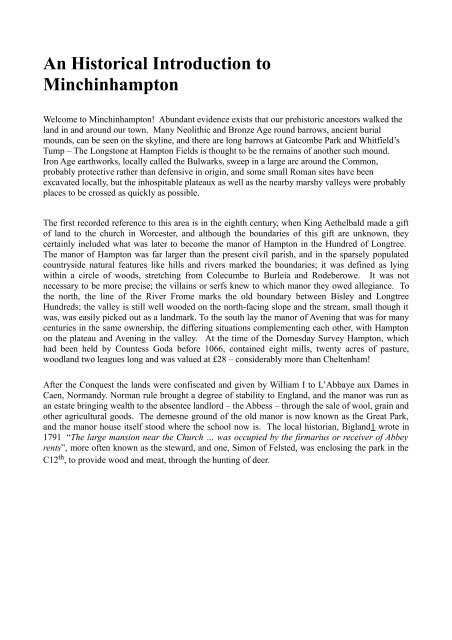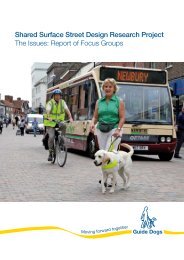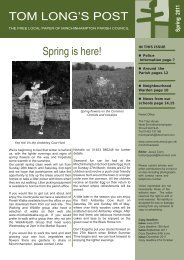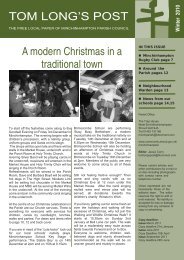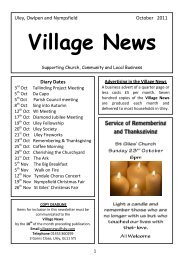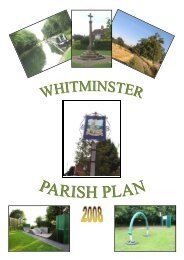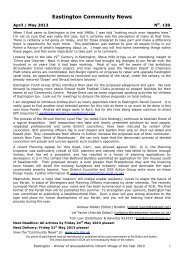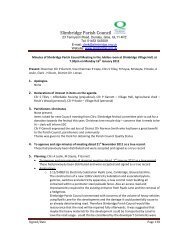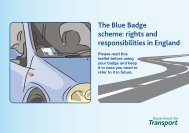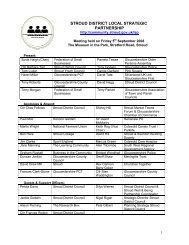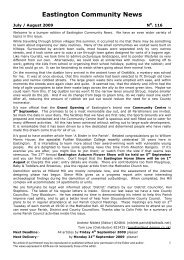An Historical Introduction to Minchinhampton
An Historical Introduction to Minchinhampton
An Historical Introduction to Minchinhampton
You also want an ePaper? Increase the reach of your titles
YUMPU automatically turns print PDFs into web optimized ePapers that Google loves.
<strong>An</strong> <strong>His<strong>to</strong>rical</strong> <strong>Introduction</strong> <strong>to</strong>Minchinhamp<strong>to</strong>nWelcome <strong>to</strong> Minchinhamp<strong>to</strong>n! Abundant evidence exists that our prehis<strong>to</strong>ric ances<strong>to</strong>rs walked theland in and around our <strong>to</strong>wn. Many Neolithic and Bronze Age round barrows, ancient burialmounds, can be seen on the skyline, and there are long barrows at Gatcombe Park and Whitfield’sTump – The Longs<strong>to</strong>ne at Hamp<strong>to</strong>n Fields is thought <strong>to</strong> be the remains of another such mound.Iron Age earthworks, locally called the Bulwarks, sweep in a large arc around the Common,probably protective rather than defensive in origin, and some small Roman sites have beenexcavated locally, but the inhospitable plateaux as well as the nearby marshy valleys were probablyplaces <strong>to</strong> be crossed as quickly as possible.The first recorded reference <strong>to</strong> this area is in the eighth century, when King Aethelbald made a gif<strong>to</strong>f land <strong>to</strong> the church in Worcester, and although the boundaries of this gift are unknown, theycertainly included what was later <strong>to</strong> become the manor of Hamp<strong>to</strong>n in the Hundred of Longtree.The manor of Hamp<strong>to</strong>n was far larger than the present civil parish, and in the sparsely populatedcountryside natural features like hills and rivers marked the boundaries; it was defined as lyingwithin a circle of woods, stretching from Colecumbe <strong>to</strong> Burleia and Rodeberowe. It was notnecessary <strong>to</strong> be more precise; the villains or serfs knew <strong>to</strong> which manor they owed allegiance. Tothe north, the line of the River Frome marks the old boundary between Bisley and LongtreeHundreds; the valley is still well wooded on the north-facing slope and the stream, small though itwas, was easily picked out as a landmark. To the south lay the manor of Avening that was for manycenturies in the same ownership, the differing situations complementing each other, with Hamp<strong>to</strong>non the plateau and Avening in the valley. At the time of the Domesday Survey Hamp<strong>to</strong>n, whichhad been held by Countess Goda before 1066, contained eight mills, twenty acres of pasture,woodland two leagues long and was valued at £28 – considerably more than Cheltenham!After the Conquest the lands were confiscated and given by William I <strong>to</strong> L’Abbaye aux Dames inCaen, Normandy. Norman rule brought a degree of stability <strong>to</strong> England, and the manor was run asan estate bringing wealth <strong>to</strong> the absentee landlord – the Abbess – through the sale of wool, grain andother agricultural goods. The demesne ground of the old manor is now known as the Great Park,and the manor house itself s<strong>to</strong>od where the school now is. The local his<strong>to</strong>rian, Bigland1 wrote in1791 “The large mansion near the Church … was occupied by the firmarius or receiver of Abbeyrents”, more often known as the steward, and one, Simon of Felsted, was enclosing the park in theC12 th , <strong>to</strong> provide wood and meat, through the hunting of deer.
Like many other places in the realm, charters were passed elevating Minchinhamp<strong>to</strong>n <strong>to</strong> the statusof a <strong>to</strong>wn, giving the right <strong>to</strong> hold a market and extract <strong>to</strong>lls, the first probably in 1213. This waswhen it first became known as Minchin-Hamp<strong>to</strong>n, from the old word mycenen meaning nun. A latercharter was granted by Henry III, which, when confirmed at Winchester on September 29 th 1269,stated “our beloved in Christ the Abbess and Nuns of Caen that they and their successors shouldforever be permitted <strong>to</strong> have a weekly market on Tuesday at their manor of Hamp<strong>to</strong>n Monialium(Minchinhamp<strong>to</strong>n) in the County of Gloucester and a yearly fair there lasting five days namely onthe Eve and Feast of Holy Trinity and the three days following”. It was, of course, the income fromthe <strong>to</strong>lls that was of interest <strong>to</strong> the absentee landlords at Caen, and it was a jealously guarded right,as another market opening close by would affect trade.With the spread of Christianity in Saxon times people began <strong>to</strong> gather around the churches <strong>to</strong>celebrate holy days and this became a chance for the sale of surplus goods, because travel was slowand sometimes dangerous and the crowds were in one place. As a priest is recorded in 1086 theremust have been a religious building in Hamp<strong>to</strong>n, but no trace of it remains. By Norman times thechurch was the most weatherproof building in a locality, and would be used for many secularpurposes such as courts, s<strong>to</strong>rage of valuables and meetings, and the porch or churchyard was anobvious site for a market. The original Holy Trinity Church, taking its dedication from the motherchurch in Caen, seems <strong>to</strong> have been similar <strong>to</strong> Holy Cross at Avening, but was in a parlous state inthe C19 th when the nave and chancel were rebuilt. Fortunately the south transept with its excellentrose window remains. The spire has had its present truncated form for many centuries; the timberswould not support the <strong>to</strong>tal weight of s<strong>to</strong>ne and it had <strong>to</strong> be finished with the distinctive corona.A statute was passed in 1285 forbidding fairs in churchyards, and by 1448 trading on a Sunday wasbanned, making Saturday the market day in many places. The trading activities had <strong>to</strong> move awayfrom the churchyard, but often set up “just over the wall” and Minchinhamp<strong>to</strong>n, like many other<strong>to</strong>wns, has its market place very close <strong>to</strong> the church. The market place was probably much largerthen, with stalls set up in what we know as Bell Lane and the area on which the present MarketHouse stands being open space. For the visi<strong>to</strong>r or resident alike, <strong>to</strong> s<strong>to</strong>p at the bot<strong>to</strong>m of Bell Laneand take a moment <strong>to</strong> visualise a manor house <strong>to</strong> the west, church <strong>to</strong> the east and market place <strong>to</strong> thesouth is <strong>to</strong> take a step back in time <strong>to</strong> the centre of the mediaeval <strong>to</strong>wn of Minchinhamp<strong>to</strong>n. Thearea around Hamp<strong>to</strong>n Fields was common arable land, worked on a three-field system, there waspasture in the valleys and woodland covered much of the hill<strong>to</strong>p, grazed by animals under ancientrights, which survive <strong>to</strong> this day on the commons. Much of this wood was gradually enclosed andthe timber cut and sold, with only the names such as Box, Beechknapp and Forwood <strong>to</strong> remind us ofthis heritage.
The manor remained under the control of religious houses until the Dissolution of the Monasteriesand shortly afterwards, in 1542, Henry VIII forced <strong>An</strong>drew, First Baron Windsor, <strong>to</strong> give him theestate of Stanwell in Middlesex in exchange for Minchinhamp<strong>to</strong>n. In 1656 Samuel Sheppardpurchased the property, enlarging the house of the steward near the church. The Gloucestershirehis<strong>to</strong>rian Sir Robert Atkyns 2 describes the house and “a spacious grove of high trees in a parkadjoining <strong>to</strong> it, which is seen at a great distance.” <strong>An</strong> engraving by Kip illustrating this accountshows a typical Cotswold gabled, s<strong>to</strong>ne-built house with a walled pleasure ground almostsurrounding it. In the northern corners are two summerhouses or gazebos, with steps for access,which overlooked a formal tree garden, parterres and terraces with the main approach <strong>to</strong> the housevia the farmyard <strong>to</strong> the south between gate piers surmounted by s<strong>to</strong>ne balls, and across a courtyard.The park <strong>to</strong> the north had been demesne land belonging <strong>to</strong> the Lord of the Manor.<strong>An</strong>other member of the Sheppard family, Philip, built the Market House in 1698. Samuel Rudder3described Minchinhamp<strong>to</strong>n a century later: “Within the parish, is a little <strong>to</strong>wn of the same name,with a market on Tuesdays, and two fairs in the year viz. one held on Trinity Monday, and the otheron the 29 th of Oc<strong>to</strong>ber … The <strong>to</strong>wn consists of four streets, in the form of a cross, with three markethouses, one of which was built in the year 1700 (sic) for s<strong>to</strong>ring of wool and yarn, in expectation ofestablishing a great mart for those commodities, as the <strong>to</strong>wn is well situated for that purpose in agreat clothing country; but it seems not <strong>to</strong> have fully answered the design”. It did appear that thewool and yarn market was successful at first, as in 1702 it was regarded as one of the four chiefwool markets in the county, and posed a threat <strong>to</strong> that in Tetbury, but the Market House was alreadybeing used for other purposes; in 1746 it was licensed as a place of worship for the Society ofFriends or Quakers, a fire engine was housed in the undercroft and there was also a lock-up behind.Just <strong>to</strong> the east of Butt Street lies Stuart House, named after the lady who lived there from 1944until her death, and the previous name, The Old Rec<strong>to</strong>ry, gives us a clue as <strong>to</strong> its his<strong>to</strong>ry. At the endof the C16 th the rec<strong>to</strong>ry house comprised hall, parlour, buttery, pantry, chambers, kitchen andoutbuildings”4 and s<strong>to</strong>od much closer <strong>to</strong> the Church of Holy Trinity, either in the Market Square orat Parsons Court. However, a petition of 1720 from Edward Sheppard who desired <strong>to</strong> build a newrec<strong>to</strong>ry, presumably at his own expense, speaks of that house as being “very old ruinous anddecayed and situate in a Low and unhealthy place”. Edward was the second of that name and hadbeen Lord of the Manor since his father’s death in 1713 and appointed his second son <strong>to</strong> the Livingof Minchinhamp<strong>to</strong>n presumably wishing for a better dwelling as befitting his status. The Rev.Philip Sheppard was born in 1695, and in addition <strong>to</strong> Minchinhamp<strong>to</strong>n became Rec<strong>to</strong>r of Avening in1728. Both rec<strong>to</strong>ries were valuable benefices and he occupied them until his death in 1768, makinga <strong>to</strong>tal of forty-nine years for Minchinhamp<strong>to</strong>n.
The reply states “The new one as proposed <strong>to</strong> be Built is <strong>to</strong> stand in a very dry and convenient placeupon the aforenamed piece or parcell of Glebe Land called the Lyes. ‘Tis <strong>to</strong> be four square with twoFronts the extent of it is <strong>to</strong> be fifty Feet on every side or thereabouts, ‘tis <strong>to</strong> be three s<strong>to</strong>reys highand there are <strong>to</strong> be four rooms in every s<strong>to</strong>rey and by the Assistance of the aforementioned workmen[Giles Whiting, carpenter and Jeremiah Jenkins, mason] we have Computed the Expense of Buildingthe aforementioned new parsonage House and the Outhouses herein after mentioned and Judge itwill be Four Hundred pounds…The outhouses proposed <strong>to</strong> be built a Brewhouse about fourteen feetsquare and a stable three bays in Length and of a proportionable Breadth.” This new rec<strong>to</strong>ry wasbuilt about a year later, <strong>to</strong> the design stated in the extract, and those who remembered it before theremodelling in Vic<strong>to</strong>rian times commented upon its well-proportioned facades, and it had narrowGeorgian sash windows, according <strong>to</strong> Arthur Playne.5 There were two entrances <strong>to</strong> the property,that from Butt Street and another <strong>to</strong> the east from the area around Glebe Farm, and it was one of thelarger dwellings in the <strong>to</strong>wn, comparing favourably with the Sheppard Manor House close by thechurch, and the Lammas <strong>to</strong> the south. All of the land <strong>to</strong> the north of Friday Street was glebe landuntil the C19 th .Minchinhamp<strong>to</strong>n is an excellent example of a small Cotswold <strong>to</strong>wn. Many of the buildings datefrom the C17 th and C18 th ; these were the great days of the woollen cloth industry that saw the areaassume a national importance. In the 1790s there was rapid growth due <strong>to</strong> the expansion in handweaving, and at least seventy cottages were built on land taken from the common betweenRodborough and Box at this time. Gradually the open stalls of the Tuesday market gave way <strong>to</strong>more permanent shops. There is evidence that the butchers’ shambles were located along thesouthern side of the churchyard, and most of the shops were positioned in the High Street (as theyare now!) The cruciform pattern of the main streets relates <strong>to</strong> the crossing of two roads, from Stroudsouth <strong>to</strong> Tetbury and Bath and east <strong>to</strong> Cirencester and London. In addition <strong>to</strong> the trade in wool, ademand grew for the Oolitic Limes<strong>to</strong>ne, and there is abundant evidence of local quarrying. Farmproduce also found a ready market in the growing cities of industrial England. When first the canal,then the new turnpike road and finally the Great Western Railway were constructed in the GoldenValley, Minchinhamp<strong>to</strong>n lost its locational advantages, but lack of growth meant that many of theolder houses have remained unencumbered by Vic<strong>to</strong>rian additions. In the High Street are thecrooked gables of the former White Hart, and opposite the fine Greylands, which was once home <strong>to</strong>the widow of <strong>An</strong>thony Trollope. The Cotswold Club, though much altered, is a C17 th house, andeven earlier are Arden House and Arden Cottage, with the archway between them showing carvedTudor roses. The pharmacy is squeezed in<strong>to</strong> a space that once led <strong>to</strong> the yard of The George, butthe largest, and only remaining, public house is The Crown. This, like The Salutation in TetburyStreet, was a coaching inn and occupies the premier position close <strong>to</strong> the centre of trade. All of thebuildings here are worthy of a close inspection, although these days they are <strong>to</strong>o often obscured byparked cars, or moving traffic!
The fairs had also become specialised – the Whitsun Fair was for cattle sales, and the Oc<strong>to</strong>ber Fairfor horses and sheep. Of course, the entertainments for the inhabitants would go on alongside theserious business, and hiring of workers would also take place. By the middle of the C19 th theOc<strong>to</strong>ber Fair was held along the road near Blue Boys, probably in much the same way the S<strong>to</strong>wHorse Fair was conducted until recently. However, the days of large lives<strong>to</strong>ck sales inMinchinhamp<strong>to</strong>n were numbered, and the local expert Arthur Playne6 comments: “Hamp<strong>to</strong>n Fairwas regularly held until recent times, and the writer remembers often <strong>to</strong> have seen the cattle andhorses in the streets. Fresh regulations were made in 1825, but both markets and Fairs have nowdisappeared, owing <strong>to</strong> the competition of the larger Markets served by the Railways, and givinggreater facilities both <strong>to</strong> buyers and sellers. But at least they have a remarkable record, havingexisted for more than six and a half centuries, and having brought considerable prosperity <strong>to</strong> the<strong>to</strong>wn and neighbourhood during that long period.”By the mid-eighteenth century the Sheppard family, whose memorials can be seen in thechurchyard, found their mansion <strong>to</strong> be draughty, outdated and difficult <strong>to</strong> maintain. EdwardSheppard chose <strong>to</strong> build a new house for his family at Gatcombe Park in 1774, preferring the rurallocation <strong>to</strong> that of his old property in the centre of Minchinhamp<strong>to</strong>n, thus distancing himself fromthe day-<strong>to</strong>-day affairs of the <strong>to</strong>wn, as did many of his contemporaries elsewhere in Gloucestershire.In the early C19 th Brewer7 wrote that Gatcombe “is placed on the ascent of a narrow valley,bounded by high beech wood, with intermingled oak and ash, on the one side whilst the risingground in the opposite direction, is decorated with clumps and other efforts of the landscapegardener. The house looks down on a spacious and fine lawn, which terminates in waters,expanded by the hand of art <strong>to</strong> an ornamental breadth of space. The present elegant house is awell-proportioned and spacious mansion, handsome on the exterior and internally well designedand arranged”.The building costs of the new mansion were, however, a drain on the resources of the Sheppardfamily, and Gatcombe Park passed out of their hands in<strong>to</strong> those of the Ricardo family, whocontinued as Lords of the Manor in<strong>to</strong> the twentieth century. George Basevi, who was alsoresponsible for the Fitzwilliam Museum in Cambridge, designed the curving conserva<strong>to</strong>ry for DavidRicardo, the eminent economist; this distinctive feature is recognised by all those who attend thethree-day events held in the park by the current owner, the Princess Royal.The <strong>to</strong>wn stagnated when bypassed by the main transport links and the fortunes of the area werealso affected by the decline in handloom weaving, which had been the home industry in many of theolder cottages. This had led <strong>to</strong> economic distress amongst the weavers, and the records of the earlyC19 th catalogue a decline in income, partly due <strong>to</strong> the blockade of English shores by Napoleon, andthen <strong>to</strong> the appearance of weaving shops in the mills of the valleys. By 1839 Longfords Mills hadninety handloom weavers and one power loom and Dunkirk had seventy-one handloom weaversand two power looms. There were protests about the latter, and Abraham Smith of Box was said <strong>to</strong>have “rio<strong>to</strong>usly and tumultuously assembled with a great concourse of people and threatened <strong>to</strong> doThomas Marling some bodily injury”8 in 1825.
The conditions were such that many people were tempted <strong>to</strong> try <strong>to</strong> gain a better life abroad andbetween 1839 and 1842 nearly fifty Minchinhamp<strong>to</strong>n weavers emigrated. A century previously theresponsibility of caring for the poor, levying a poor rate and the repair of the highways were laidupon local vestries. These developed from parish meetings, which consisted of all the male churchmembers who met once a year <strong>to</strong> elect churchwardens. The ecclesiastical work of the vestry hadbecome submerged in the concerns of the <strong>to</strong>wn and tithing, the rural neighbourhood, and themeetings usually consisted of a few men who were concerned with a particular issue, but the namewas retained. However, even though unelected, the Minchinhamp<strong>to</strong>n Vestry carried outconsiderable improvement work in the C19 th including the provision of a fire engine, lock-up, gaslighting and purchasing one of the cottages in the churchyard for the Sunday School and for vestrymeetings, which had previously been held in the upper room of The Crown opposite. When theelected Parish Council replaced the Minchinhamp<strong>to</strong>n Vestry at the centre of local affairs in 1894, it<strong>to</strong>ok over the property and the council has met there ever since, making it the centre of localgovernment for over a century and a half.The site of the old manor house had been sold during the Napoleonic Wars, and in the 1820s acertain William Whitehead conceived the idea of building himself a mansion, <strong>to</strong> be calledMinchinhamp<strong>to</strong>n Abbey, on its site. Foundations were laid, the walled garden set out, but hemanaged <strong>to</strong> lose a fortune at the gaming tables and the land was sold <strong>to</strong> David Ricardo, thuscompleting the circle of ownership. It was the Ricardo family who donated the land on which thefirst Minchinhamp<strong>to</strong>n Schools were built in 1868, having established a school in the Market Housefifty years earlier. The present school is the third on the site, the last one having survived just thirtyyears from 1968. In Bell Lane, so called not for the church bells but from an inn that s<strong>to</strong>od there, isthe Master’s House, built at the same time as the original school.Throughout the Vic<strong>to</strong>rian period conditions for the inhabitants of Minchinhamp<strong>to</strong>n graduallyimproved. The remaining stretches of open fields had been enclosed and many farms requiredlabour, especially <strong>to</strong> the east of the <strong>to</strong>wn. Many women found work in the spinning mills of thevalleys, and their menfolk accepted employment on the power looms. Other mills made walkingsticks and umbrella frames, and new engineering industries could be found at Brimscombe, Thruppand Nailsworth. The small cottages in West End, Tetbury Street and lower Butt Street becamehome <strong>to</strong> larger families, as more children survived infancy, and vegetables from the garden, where afew chickens and possibly a pig would be kept, supplemented the diet. Just below the spring thatgave Well Hill its name is King Street; this was once the poor end of <strong>to</strong>wn and the row of cottageshas date s<strong>to</strong>nes, more recent as you ascend the hill. Spanning the lane are three bridges, probablymade because this was an ancient right of way and pedestrians could use it without seeing thegrounds of the Lammas, and themselves being invisible from the house! The path emerges oppositePark Terrace, or The Buildings. These cottages date from 1833 and were originally for the workerson the Gatcombe estate. There is a s<strong>to</strong>ry that soon after Park Terrace was built, a member of theRicardo family passed in a carriage and saw washing hanging in front of the cottages, as this wasthe only garden for the tenants at that time. The sight so offended the sensibilities that rear gardenswere provided for each cottage!
By the 1880s Tetbury Street was home <strong>to</strong> many craftsmen, without whom a settlement such asMinchinhamp<strong>to</strong>n could not survive. Apart from the building trades, including tilers and plasterers,carpenters and a gas fitter, there was a master cabinetmaker employing two apprentices living onthe north side of the street. Associated with transport there were a wheelwright (with another whodescribed himself as retired), a saddler and harness maker and a blacksmith, and another forge was<strong>to</strong> be found in Butt Street. The trade direc<strong>to</strong>ries of the time suggest that the chimney sweep and thecoal dealer carried on their work from their cottages in Tetbury Street, as did three dressmakers andtwo milliners.Holy Trinity Church remained the focus for a large proportion of the population, and acomprehensive rebuilding exercise was carried out on the chancel and nave, which had been indanger of collapse. However, the Baptist Chapel was completed in 1834 <strong>to</strong> replace the smallermeeting-room in Workhouse Lane, which was converted for use by the Sunday School. By the endof the Vic<strong>to</strong>rian period the church was strong both numerically and spiritually, with many membersliving close by in Tetbury Street, the non-conformist creeds having a great appeal <strong>to</strong> working menand women.[1]. Sunday School was a way of furthering the general education of adults whoworked all week, and was enthusiastically encouraged by <strong>An</strong>glicans and Baptists alike. Concerts,plays and readings were regularly held in the Market House, and the Mutual ImprovementAssociation organised a series of lectures in the mid C19 th , all designed <strong>to</strong> improve the life of theworkingman or woman. Even the schools offered what would now be known as “life-longeducation”!There were, of course, less serious diversions for the growing population. The Whitsun Fair hadevolved in<strong>to</strong> two parades, held by the <strong>An</strong>glican and Baptist churches, culminating in tea and sportson the Great Park, and, later, a free ride on the roundabout set up there. The Rogers family havebrought their travelling funfair <strong>to</strong> the commons for at least eighty years, at first using steam tractionengines, of which several pictures exist. Many of the older generation have fond memories of theseparades, which continued until well after World War II, and enterprising children managed <strong>to</strong> attendboth the Whit Sunday and Whit Monday picnics! Sometimes all the non-conformists of the areamet <strong>to</strong>gether; on one occasion nine Sunday Schools assembled, with nearly nine hundred childrenpresent, accompanied by two bands of musicians and around a thousand specta<strong>to</strong>rs with carriagesvarying “from the stately barouche and pair <strong>to</strong> the smaller one-horse trap”. After sports and gamesthere was “an abundant supply of cakes and other food”.10 One of the bands was probably theMinchinhamp<strong>to</strong>n Town Band, which regularly practised in the Market House. Slightly less decorouswere the gatherings at the many public houses within the <strong>to</strong>wn, several of which were supplied fromPlayne’s Brewery at Forwood. Indeed, the congregation of the Baptist Church became soconcerned that early in the C20 th the Institute was built on their land, as a meeting place for the menof the <strong>to</strong>wn, where no alcohol would be served!
Minchinhamp<strong>to</strong>n Common was beginning <strong>to</strong> assume its role for recreation, in addition <strong>to</strong> that ofcommon farmland. In Vic<strong>to</strong>rian times the duty of administering the common pasture was graduallyassumed by a Committee of Commoners, which kept detailed minutes throughout the C19 th . Theywere concerned for their cattle, and damage of any sort <strong>to</strong> the turf brought an immediate response.In 1847 James Harrison of Littleworth was threatened with prosecution for “injuring a s<strong>to</strong>netrough”. It had previously been reported that the weather had been so unusual that all the pools onthe commons had dried, and water for the beasts was only obtained with great difficulty. Otherissues tackled were taking land in<strong>to</strong> the Common, dealing with straying cattle and with thequarries. There were two large areas of arable land left, one <strong>to</strong> the north of Box and the otherstretching in a broad arc northwards from the windmill. When an occupier of land wished <strong>to</strong>straighten his boundary or enlarge his garden permission was granted provided he threw in<strong>to</strong> thecommon as large, or a larger piece of ground. Mrs. Frith made the road from the Halfway House <strong>to</strong>Tom Longs Post, in return for taking in 3½ acres of common land in<strong>to</strong> the grounds of Highlands,now Beaudesert School. Near Windmill House the footings of the original wall of the field atCharity Barn can be seen.Cricket was played on Minchinhamp<strong>to</strong>n Common, near <strong>to</strong> the windmill although conditions werefar from ideal, a match between Nailsworth and Minchinhamp<strong>to</strong>n yielding a score of visi<strong>to</strong>rs 26,home team 86! There would be a mown strip, as the early accounts of this local M.C.C. indicate,but this would not have been rolled, and "bouncers" would catch many experienced batsmenunawares. The open land was undoubtedly the scene of many local sporting events, from football <strong>to</strong>horse racing, and the area by Dr. Brown’s Road, then part of Burleigh Lane, was regularly used formilitary gatherings and manoeuvres, thus acquiring the name Camp Field; a copse of trees and aflagstaff marked the centre of the parade area. As the Ricardo family lived at Gatcombe, their oldpark had become somewhat of a public open space, although it was never part of Minchinhamp<strong>to</strong>nCommon, with all the rights that entailed. Along the northern boundary of the Great Park was awall and ditch with entrance gateways or arches, still visible in the line of brambles <strong>to</strong>day. Closer <strong>to</strong>the schools, on a concrete plinth, there s<strong>to</strong>od a large gun that might have been captured from theRussians in the Crimean War. Certainly two cannon from the Siege of Sebas<strong>to</strong>pol were erected infront of the Subscription Rooms in Stroud. Nailsworth, <strong>to</strong>o, was presented with a gun but they put i<strong>to</strong>ut of sight possibly “<strong>to</strong> intimate the great blessing it would be <strong>to</strong> mankind if all the warlikeinstruments in the world lay as peaceful and quiet as theirs”.11 This poses a question: at that timeNailsworth was not a parish in its own right, but part of Minchinhamp<strong>to</strong>n, so was this the gun thateventually ended up here?
In the his<strong>to</strong>ry of sport a date of national significance is March 14 th 1889, when the Minchinhamp<strong>to</strong>nCommons Golf Club was formed, and it was decided that the headquarters would be the Old Lodge.The Lodge had become an inn by the beginning of the C18 th and is shown on maps of the periodwith a small enclosure <strong>to</strong> the west and a bowling green <strong>to</strong> the east; some notable extensions <strong>to</strong> thebuilding <strong>to</strong>ok place at this time. The name Old Lodge was coined when a New Lodge Inn wasopened in Amberley in the C19 th , and the close link with the Golf Club remained for over a century.A national periodical stated: “perhaps the best inland golfing course is Minchinhamp<strong>to</strong>n Common,… with picturesque surroundings and an exceptionally pure and bracing air”12. In the same yearthe Minutes of the Committee of Commoners report that Mr. Shipway asked, “On what authorityholes were made on the Common?” The Chairman, Mr. Playne, himself a keen golfer, said that theLord of the Manor had given permission and that he hoped there was not going <strong>to</strong> be any objection<strong>to</strong> a game that brought strangers in<strong>to</strong> the area. It was not the game Mr. Shipway objected <strong>to</strong> butplayers who had threatened <strong>to</strong> prosecute people who complained; the holes were four inches wideand quite enough <strong>to</strong> lame a horse. Many men were members both of the Golf Club and CommonersCommittee, the dispute died away, and the two have existed side by side ever since. H.G. Ricardosold the Great Park <strong>to</strong> Minchinhamp<strong>to</strong>n Golf Club in 1907, the wall was removed and thirty acres ofgrazing land were added <strong>to</strong> the common pasture “for grazing in return for the Club’s formal right <strong>to</strong>play golf and maintain the course”. Whenever there were disputes about the fairways being mownin the closed season, graziers were reminded about these thirty acres of private land!The Ricardo family continued as Lords of the Manor throughout the C19 th and early C20 th , takingtheir responsibilities seriously. They paid for the first real drainage system in the <strong>to</strong>wn, paved theundercroft of the Market House so that it could be used for trading in all weathers, supported bysubscription and by gifts of land both the <strong>An</strong>glican and Baptist Churches, and the Schools. Inresponse <strong>to</strong> growing fears about piecemeal quarrying destroying Minchinhamp<strong>to</strong>n Common, andthus the grazing, Major H.G. Ricardo signed an agreement with the National Trust in 1913, so thatit should be “devoted <strong>to</strong> the enjoyment of the public and … preserving the natural aspect andfeatures of the said common”13. It was not until 1981 that the Golf Club offered the Great Parkfor sale at £15,000, plus legal fees, <strong>to</strong> the people of Minchinhamp<strong>to</strong>n. A public appeal waslaunched in conjunction with the National Trust, the money was raised and the land finally passedin<strong>to</strong> public ownership. The last great gift, however, was in 1920, when H.G. Ricardo handed theMarket House over <strong>to</strong> a committee for the <strong>to</strong>wn, and since that date it has performed the functionof a village hall.
Population was attracted in<strong>to</strong> the area in the early years of the last century, and it has beensuggested that the increase in building around the area was due <strong>to</strong> the open space and nearby golfcourse, whilst “the beauty of the scenery and the healthiness of the situation making it a favouriteplace of residence”1. These reasons still hold good <strong>to</strong>day! Both on the northern and southernfringes of the <strong>to</strong>wn there are examples of “Arts and Crafts” houses. On the north side of the GreatPark are the gabled Frome Top, Highfield, Greys<strong>to</strong>nes “probably by Jewson ... a more refinedversion of Highfield” and Upmead, “in much more spacious grounds, 1925 by Falconer, Baker andCampbell for Miss Hartley, the jam heiress.”[2] Hunters Lodge is probably by Ernest Barnsley,dated c1922. Two other large houses by Thomas Falconer stand on the south side of the park,Bowman’s Green and Windrush. The former is on a butterfly-shaped plan, and there are smallerhouses of 1933 on the Butt Street side. The work people of the <strong>to</strong>wn still inhabited the smallercottages, some of which, like those in West End, had changed little since the C17 th . This roadcarried the main traffic in<strong>to</strong> the <strong>to</strong>wn and it was busy with horse traffic, although without a firmroad surface or pavements which did not appear until much later. One householder was fined forhaving two heaps of manure in front of his cottage!The two global conflicts of the C20 th had a profound impact upon the area. In World War I manyyoung men, as happened all over the Empire, answered the call <strong>to</strong> arms, some never <strong>to</strong> return. Intheir memory a subscription list was set up, and as well as contributions from the gentry, majorhouseholders and working classes there was a donation from the Australian Flying Corps who werebased at Minchinhamp<strong>to</strong>n Aerodrome at the end of the war. The initial plan was <strong>to</strong> purchase theLower Island buildings that s<strong>to</strong>od at the <strong>to</strong>p of the High Street, <strong>to</strong> use as almshouses or a club forreturning soldiers but they were very dilapidated, and a decision was taken <strong>to</strong> remove them anderect a memorial cross in their place. Sidney Barnsley, one of the celebrated craftsmen known asthe Sapper<strong>to</strong>n Group, was chosen <strong>to</strong> design the memorial. He is responsible for other crosses inGloucestershire and his brother, Ernest, was the architect of Westfield at Park Corner.In 1938, less than twenty years after the dedication of the War Memorial, R.A.F. As<strong>to</strong>n Down wasopened, the name having been changed at the request of the residents of Minchinhamp<strong>to</strong>n whofeared, not enemy attack, but a fall in the value of their houses! This was <strong>to</strong> become a major centrefor the maintenance of both fighter and bomber aircraft, and for the training of the pilots andaircrew.At the outbreak of war, evacuees came <strong>to</strong> the area, first from Birmingham and later from Essex, andyounger visi<strong>to</strong>rs were incorporated in<strong>to</strong> the rolls of Minchinhamp<strong>to</strong>n and Amberley Schools. Twoboarding schools from the London area found new premises here, which they occupied for severalyears. Local hotels also played a part, not only providing accommodation for people moving fromthe Home Counties, but their grounds were also used for fund-raising events for the war effort.Lady de Clifford, Norman Hartnell, Lady Baden-Powell and the novelist P.C. Wren all spent sometime at Moor Court Hotel in Amberley.
The civilian population felt directly involved in the conflict, and Minchinhamp<strong>to</strong>n was ready forany attacks, with several local Home Guard Companies. As<strong>to</strong>n Down was thought <strong>to</strong> be the maintarget for the enemy, but “If these preliminary attacks were successful the enemy might signal forairborne reinforcements. Troop carrying planes require more space for landing and wouldprobably choose the common between Amberley and Minchinhamp<strong>to</strong>n. Here again the generalmovement would be eastwards, and Minchinhamp<strong>to</strong>n or its approaches would almost certainlybecome involved in fighting, as the <strong>to</strong>wn lies in the direct path of the hostile operationenvisaged.”16. Thankfully, the threat never came, and as the tide of war turned, the Great Parkbecame home for a few months <strong>to</strong> American soldiers who were preparing for Operation Overlord.They were an engineering company, and in a dry summer the marks of their roads and huts can stillbe traced. This was the era of a colour bar in the U.S. Forces; the black Americans had a camp nearBox. For many children this was the opportunity <strong>to</strong> sample chocolate and sweets, or nylons for theyoung women, who fondly remember the G.I.s at the dances held in the Market House. A year laterthe return of peace was celebrated with great gus<strong>to</strong> in Minchinhamp<strong>to</strong>n. A band of people with abarrel organ and monkey made an impromptu collection of £50 for children's tea and sports. FridayStreet was decorated with beech boughs, renamed "Hero Street" and the oldest resident crowned"Queen of the Street”. Chairs were put out, wine was drunk from the barrel and a piano wasproduced for dancing. A church service was held, and a bonfire lit in the Market Square. TheGloucestershire Regiment was serving in the Far East, so the <strong>to</strong>wn celebrated the vic<strong>to</strong>ry overJapan, with residents donning fancy dress and entertaining the children. In the evening a <strong>to</strong>rchlightprocession made its way <strong>to</strong> the Park where a bonfire was lit.Until the 1950s life remained hard for much of the English population, and with building materialsin short supply, and efforts concentrated in rebuilding the cities, little changed in the rural parts ofGloucestershire. Farmland could still be found close <strong>to</strong> the centre of <strong>to</strong>wn, and many of thecottages were in need of urgent updating. Mains electricity had come <strong>to</strong> the <strong>to</strong>wn in the late 1930s,but the old gas streetlights were not converted until 1953. However, new housing began <strong>to</strong> beprovided, starting with the development of council housing on the fields at the Glebe. Severalphases were constructed, including George Pearce House, consisting of sheltered accommodationfor the elderly. A small road off West End leads <strong>to</strong> Park Farm Court, another group of elderlyperson’s dwellings converted from old farm buildings and still called “The Piggeries” by olderresidents! Private houses were created out of the barns and sheds of the farm. The greatest periodof expansion was the mid 1960s, when the fields either side of Dr. Brown’s Road were developedwith houses and bungalows, and a similar estate built at what became known as Besbury Park.Over four hundred dwellings were added <strong>to</strong> the <strong>to</strong>wn in a period of just three years.
With an increase in population came the need <strong>to</strong> increase the services provided byMinchinhamp<strong>to</strong>n. A new doc<strong>to</strong>r’s surgery and library were provided on land <strong>to</strong> the south of theschool and the Vic<strong>to</strong>rian building of the latter was replaced with one that could accommodate overthree hundred pupils. A Youth Centre was built in Tobacconist Road, and the field behind StuartHouse was conveyed <strong>to</strong> the Sports Association, <strong>to</strong> provide cricket and football pitches and tenniscourts. Miss Stuart, although disabled by polio as a child and confined <strong>to</strong> a wheelchair, <strong>to</strong>ok a greatinterest in Minchinhamp<strong>to</strong>n life and allowed her grounds <strong>to</strong> be used for fetes. Upon her death, shebequeathed The Old Rec<strong>to</strong>ry <strong>to</strong> the Gloucestershire Association for the Disabled, who renamed itStuart House. Both the main buildings, and others in the grounds, were made fully wheelchairaccessible, and the gardens <strong>to</strong> the south remodelled for disabled gardeners. A large assembly halland kitchen facilities were built, enabling activities such as wheelchair dancing <strong>to</strong> be taught. Afunding crisis within the G.A.D. led <strong>to</strong> a reappraisal of its role, and it was eventually sold <strong>to</strong> EnglishCourtyard, which has once more brought this part of <strong>to</strong>wn in<strong>to</strong> the forefront of community life, withthe development of Stuart Court.No neighbourhood can stand still, and change has been the lifeblood for Minchinhamp<strong>to</strong>n for over amillennium. Modern structures and C21 st lifestyles exist alongside his<strong>to</strong>ric buildings and centuries’old traditions. Many of the small cottages in the Conservation Area have been enlarged, or twoknocked in<strong>to</strong> one, but planning controls ensured the his<strong>to</strong>ric appearance was maintained. Infillingwith new houses has continued, and some commercial premises have been converted, asexemplified by Simmonds Court, marking the site of the builders’ yard of J. Simmonds, whoseadvertisement can be seen on the gable end. <strong>An</strong>other part of their premises, The Trap House, isnow, after several transformations, the centre for the Parish Council. In these days of Internetshopping many businesses and services still flourish in the centre of <strong>to</strong>wn, ready <strong>to</strong> welcome thevisi<strong>to</strong>r or new resident <strong>to</strong> become a part of this community in the Cotswolds.© Diana Wall, Minchinhamp<strong>to</strong>n Local His<strong>to</strong>ry Group, 2006Revised 2009
Acknowledgements:Thanks are due <strong>to</strong> Howard Beard for the his<strong>to</strong>rical pho<strong>to</strong>graphs, Hugh Kearsey for the pho<strong>to</strong>graphof the painting of the Windmill and the Minchinhamp<strong>to</strong>n Local His<strong>to</strong>ry Group, Millennium Projectfor the colour pho<strong>to</strong>graphs of Minchinhamp<strong>to</strong>n.1Ralph Bigland “<strong>His<strong>to</strong>rical</strong>, Monumental and Genealogical Collections relative <strong>to</strong> the County ofGloucester” 17912 Robert Atkyns “The <strong>An</strong>cient and Present State of Gloucestershire” 17123 Samuel Rudder “A New His<strong>to</strong>ry of Gloucestershire” 17994 Nicholas Herbert “Vic<strong>to</strong>ria County His<strong>to</strong>ry” 19795 A.T. Playne “Minchinhamp<strong>to</strong>n and Avening” 19156 A.T. Playne “Minchinhamp<strong>to</strong>n and Avening” 19157 J.N. Brewer “Delineations of Gloucestershire” 18278 “Report on the Condition of Handloom Weavers” 18399 “A Brief His<strong>to</strong>ry of Minchinhamp<strong>to</strong>n Baptist Church” 200010 “Stroud Journal” 183311 Paul Hawkins Fisher “Notes and Recollections of Stroud” 187112 “Illustrated London News” 189013 “Management Agreement for Minchinhamp<strong>to</strong>n Common” 191314 A.T. Playne “Minchinhamp<strong>to</strong>n and Avening” 1915[2] 15 D. Verey and A. Brooks “The Buildings of England, Gloucestershire 1 – The Cotswolds”199916 “Minchinhamp<strong>to</strong>n War Book” 1942


